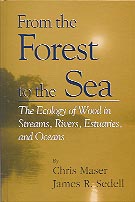Also See: Table of Contents,
Endorsements, and Purchase Information

FOREWORD
The forest and the sea have always been connected in human mind and myth,
as well as ecologically. For most of our history, we have gone "down to the
sea in ships" made from trees, emulating driftwood, which was probably the
original model for the whole process. In any event, the knitting together
of sea and land by rivers, logs, fish, soil, and tides is basic to the ecology
of all coastal margins where forests occur. Because most great rivers rise
in forested places and run to the sea, the connection is fundamental and
well-nigh universal and extends far inland and upland from the coast.
How interesting, then, and how devastating a commentary on the current state of our disciplinarily fragmented science, that the people who study forests
and the people who study salt water rarely interact. How peculiar that is
has been only in the last two decades that we realized that much of the
"sediment" in the coastal rivers that found its way to estuaries and coastal
waters of the Pacific Northwest, the setting for this marvelously inquisitive
book, was solid wood.

Wood is the forest's gift to the sea; water is the sea's gift to the forest.
The authors offer a combined historical and ecological perspective rare in "nature" books. As they recount, their puzzlement at the great decline in the amount of wood on the beaches of the Pacific Northwest during their lifetime made them curious, and this put them on a trail that led them back to earliest European settlement and into contemporary oceanography laboratories. The book is idiosyncratic in the good sense of the word; that is, it is obviously the product of the authors and no one else, which you will quickly realize if you have the pleasure of knowin them.
This is a book everyone should read. It describes a connection that is both vital to ecological and commercial health and one which we have chosen, as least recently, to know little about. The connection between logs, rivers, and ocean life is both easier to see and easier to understand, once explained, than the esoterica of ants in the Amazon or "biogeochemical cycles." It
illustrates deftly that it is the connections that count. We ignore them
at our peril. The odds are that you won't again ignore this one if you read
on.
John C. Gordon
Pinchot Professor of Forestry
Yale School of Forestry and Environmental Studies
April 1994
(Return to Top of Page)
TABLE OF CONTENTS
-
PREFACE
PART I: THE PRESENT--A SEVERED CONNECTION
CHAPTER ONE: EUROPEAN SETTLEMENT AND LAISSEZ FAIRE CAPITALISM
PART II: FROM THE FOREST TO THE SEA--SOURCE, FUNCTION, AND TRANSPORT OF
DRIFTWOOD
-
CHAPTER TWO: THE STREAMS
The stream-order continuum
Where does driftwood come from?
The function of driftwood
CHAPTER THREE: THE MCKENZIE RIVER
The stream-order continuum revisited
Driftwood on the floodplain
CHAPTER FOUR: THE WILLAMETTE AND COLUMBIA RIVERS
Of floods and driftwood
CHAPTER FIVE: THE ESTUARY
How estuaries function
Gribbles
Shipworms
Driftwood in estuaries
How some animals use driftwood
Driftwood and salt marshes
-
CHAPTER SIX: THE SEA
Driftwood in the open ocean
Driftwood, currents, and beaches
Driftwood battering rocky shores
Driftwood as habitat and food
Driftwood and tuna
Borers of the deep
PART THREE: SETTLEMENT--FROM THE SEA TO THE FOREST
-
CHAPTER SEVEN: THE SEA AND ESTUARIES
Historical perspective
Today's legal and policy perspective of beached driftwood
CHAPTER EIGHT: THE RIVERS AND STREAMS
Historical perspective
Where do we stand today?
-
APPENDIX: COMMON AND SCIENTIFIC NAMES OF PLANTS AND ANIMALS
GLOSSARY
-
ENDNOTES
REFERENCES
-
INDEX (Return to Top of Page)
Endorsements: